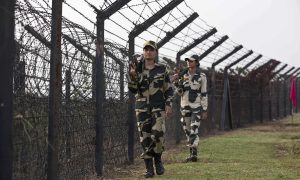It was a typical day in April 2018, usually the hottest month of the year in Bangladesh. Rasel Miah, a 14-year-old boy hailing from Phulbari Upazila in Kurigram, accompanied his father Md Hanif Uddin, a farmer, to their field near the Bangladesh-India border, just beyond the 150-yard No Man’s Land. As the sun began to set, Miah and his father were wrapping up their work to go home. Miah was holding onto the rope of their cow when out of nowhere two members of India’s Border Security Force (BSF) rushed toward them.
“I was dressed in a lungi [a traditional garment worn by men in Bangladesh and various Asian countries] along with a t-shirt while holding our cow’s rope. As they started to run to us, I ran with our cow. At one point, I jumped into a river, and suddenly, a BSF member fired chita guli [rubber bullets],” Miah, now 20 years old and studying philosophy at Uttar Bangla College in Lalmonirhat, another northern bordering district of Bangladesh, recounted to The Diplomat.
“For a few minutes, I couldn’t see anything, and to this day, I still don’t see with my right eye,” he said.
“They claimed I was cutting the barbed wire fence. How could a 14-year-old boy cut the barbed fence of an international border? After returning home, the people who were working alongside us in the field mentioned that the BSF member appeared to be drunk at that time.”
There was extensive media coverage of the encounter and Miah’s injury. Following a diagnosis at a nearby hospital, Miah’s family transferred him to Dhaka, the capital of Bangladesh, where he underwent a month-long examination at a government hospital. Unfortunately, despite the efforts, he never regained vision in his right eye.
After the incident, the Indian foreign secretary at the time, Harsh Vardhan Shringla, promised to Miah’s family that India would bring the BSF member responsible to justice. Additionally, the Indian government provided him with the opportunity to seek more advanced treatment at a hospital in New Delhi. Despite two visits, his eye remained unable to see.
“After two years, when lockdowns were implemented [to stop] the spread of COVID-19, our contact was severed. Since then we have tried to contact the Indian High Commission but it’s failed,” Miah shared.
“I still don’t know if that BSF soldier got punished or not. Besides blindness, I still have to suffer from various health issues often such as fever, headaches, and more.”
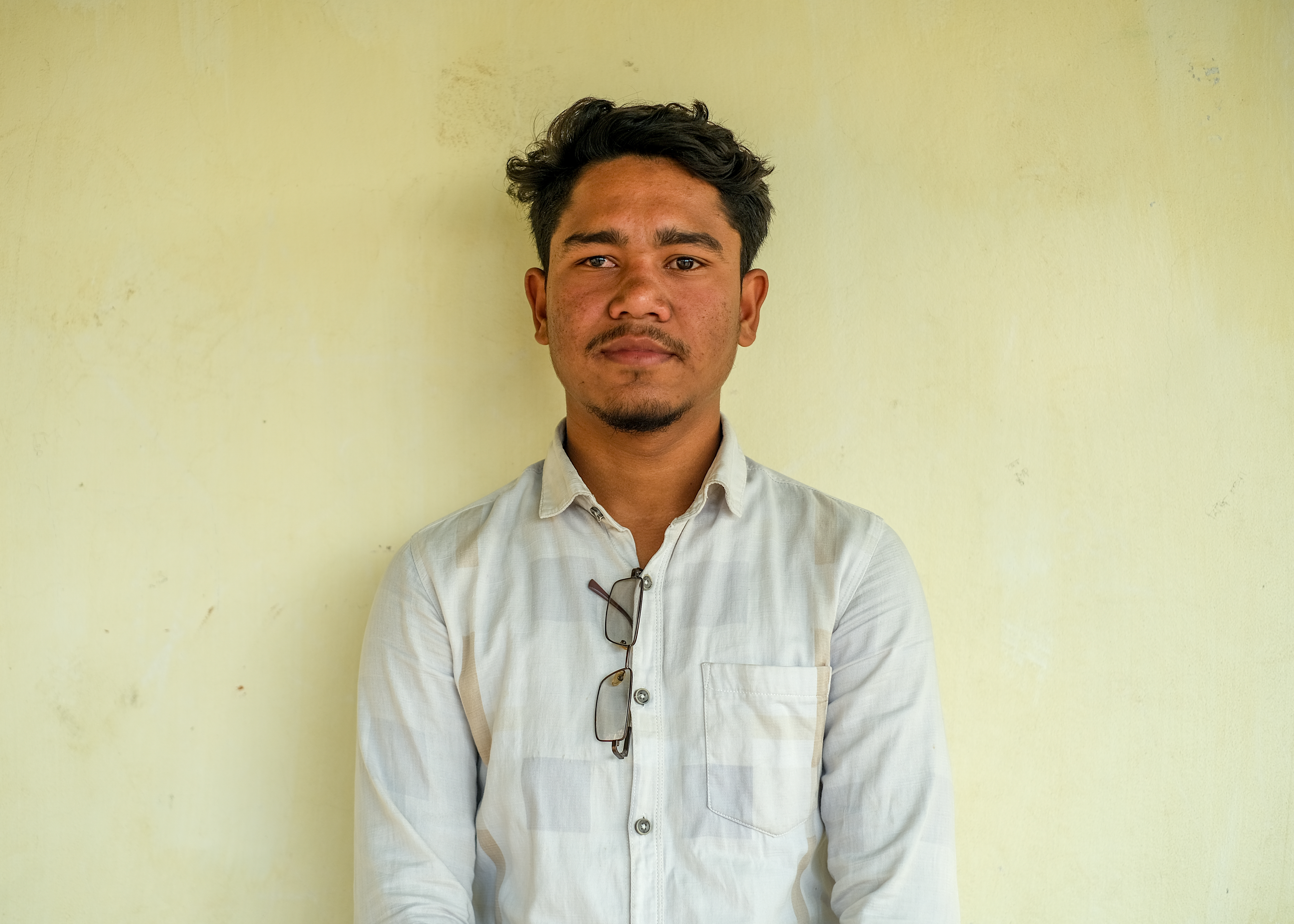
Rasel Miah has been without sight in his right eye since 2018, when a BSF soldier fired a rubber bullet at him. Photo by Saqlain Rizve.
Bangladesh and India share a 4,096-kilometer border, the fifth-longest in the world. The border separates the six divisions of Bangladesh and the Indian states of Assam, West Bengal, Mizoram, Meghalaya, and Tripura. The border has been a source of various issues, such as smuggling, illegal immigration, cross-border terrorism, and human rights violations.
It also includes some enclaves, which are pockets of land embedded entirely in the foreign territory of the other country. In 2015, India and Bangladesh exchanged 162 enclaves, simplifying the land boundary and offering the choice of citizenship to the enclave residents.
Since Bangladesh gained independence in 1971, the two countries have forged a robust and enduring friendship. This strong bond is deeply embedded in a shared history, culture, and common values. India even helped Bangladesh – then East Pakistan – to gain independence from Pakistan and gave shelter to an estimated 10 million refugees during the Liberation War.
Over the nearly past five decades, both nations have diligently worked toward strengthening their political, economic, trade, and cultural connections. Regular high-level exchanges and visits between leaders of India and Bangladesh have been a consistent aspect, underscoring the profound and meaningful nature of their bilateral relations. From an economic perspective, Bangladesh holds strategic importance for India, emerging as its largest trading partner in the subcontinent. Bilateral trade has prospered, with substantial investments from Indian companies contributing significantly to Bangladesh’s economic advancement.
However, this friendship has faced significant criticism and anti-India sentiment from various political parties in Bangladesh, as well as among the general citizens. The Indian government has wielded considerable influence in Bangladesh elections, particularly over the past decade.
The Awami League (AL), a political party known for its pro-Indian stance, emerged victorious in Bangladesh’s national election in January for the fourth consecutive time, with the main opposition party, the Bangladesh Nationalist Party (BNP), choosing to boycott the election. As per national and international media reports, political experts, and Bangladeshi opposition leaders, New Delhi reportedly influenced the United States and European Union to refrain from exerting pressure on Dhaka to uphold the democratic process.
Among the Strong Friendship, Why Are There So Many Bullets?
Despite the friendly political relations, the border area is fraught with tension – and violence.
According to Ain o Salish Kendra, a human rights organization in Bangladesh, between 2013 and 2023 a total of 332 individuals were reported killed by the BSF near the Bangladesh-India border, an average of 30 per year.
And that estimate is on the low side. Another rights group reported that at least 1,236 Bangladeshis were killed and 1,145 injured in shootings by the BSF between 2000 and 2020.
According to Dr. Mohammad Abdur Rab’s book, “Bangladesh: Geography, Geopolitics, and Environment,” a total of 206 Bangladeshi civilians were reported killed by the BSF from 1990 to 1999.
Smuggling activities are prevalent along the border, involving the illegal transportation of cows, drugs, arms, and other goods. However, the use of lethal weapons against suspected smugglers raises serious concerns. There have been numerous cases where innocent individuals were shot by BSF or abducted, actions that blatantly defy both legal and moral principles.
“Accepting that smuggling is a crime, law enforcement agencies are required to apprehend the criminal, produce him before a court, and it would be for the judge to decide what punishment was to be administered. However, the high leadership of India is on record saying that as long as ‘crimes’ along the border will be there, border shootings will also continue,” Md Touhid Hossain, former foreign secretary of Bangladesh, told The Diplomat. “Notably, the records indicate that the BSF intentionally shoots to kill. Non-lethal injury is comparatively rare.”
“In my view, and I know many who also feel the same way, this is a phenomenon that is completely unacceptable. There is no reason why this should be a regular feature at the border between two countries who are supposedly role models for bilateral relations.” he added.
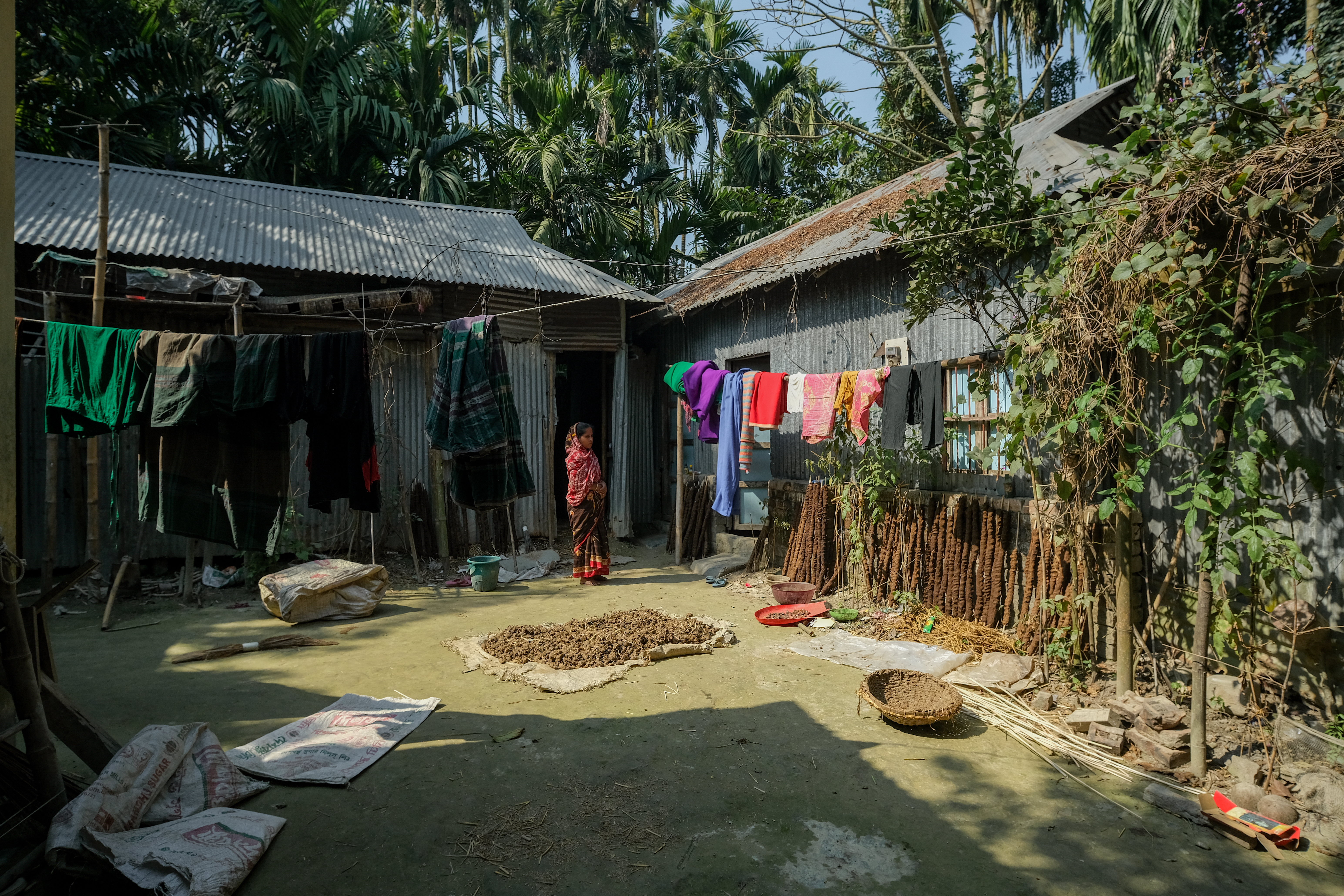
Felani Khatun’s Home at Ramkhana union in Nageshwari upazila of Kurigram district. Photo by Saqlain Rizve.
An Unforgettably Brutal Case
Perhaps the most notorious case occurred on January 7, 2011, in the Anantapur border area in Kurigram. It is in this district that the Brahmaputra, a Himalayan river that starts its journey from the Kailash ranges, enters Bangladesh, where it is known as the Jamuna River. Every year, millions of gallons of water flood the district and make the lives of the civilians difficult.
On that day, a 14-year-old girl’s body was left hanging on the barbed wire fence that separates the two countries.
The girl was Felani Khatun, a Bangladeshi who used to live with her parents in Assam, a state of India bordering Bangladesh. She was supposed to don a red saree and jewels, traditional Bengali wedding attire, and sit in the wedding hall on January 8. To that end, she and her father, Md Nurul Islam Nuru, were illegally crossing the border with the help of brokers.
Her father crossed the fence successfully. Then it was Felani’s turn. When she climbed to the fence with a ladder, she was shot by a BSF soldier.
Felani was left hanging on the fence for about four hours. During that time, she was still alive; villagers reported hearing her pleas for water and assistance, yet fear kept them from approaching. Gradually, Felani succumbed to her injuries and took her last breath.
Thirty hours later her dead body was brought back, bound to a bamboo pole with her hands and feet restrained. She wore a white shroud instead of a red saree.
The image of her body – first alive, then dead – hanging on the fence is enough to make many question the friendship between Bangladesh and India. And Felani was not the first or the last Bangladeshi civilian to be killed along a border that is among the world’s deadliest, despite linking two friendly nations.
Amidst public outcry in Bangladesh, Amiya Ghosh, a BSF soldier, faced charges. Despite a trial and retrial, he was finally acquitted on September 6, 2013, citing inconclusive evidence.
Nuru, Felani’s father criticized the BSF court’s decision as a “mockery of justice.”
After that an Indian human rights organization, MASUM, sought compensation from the Indian National Human Rights Commission, resulting in a directive for the Indian government to pay half a million rupees. However, Felani’s family is still awaiting the payment of this compensation.
“My daughter was shot and left hanging on barbed wire like a bird by the BSF. There is no record of the amount of my girl’s blood that fell on the ground. It’s been 13 years, and I still haven’t received justice. How much longer must I wait for justice?” Nuru said.
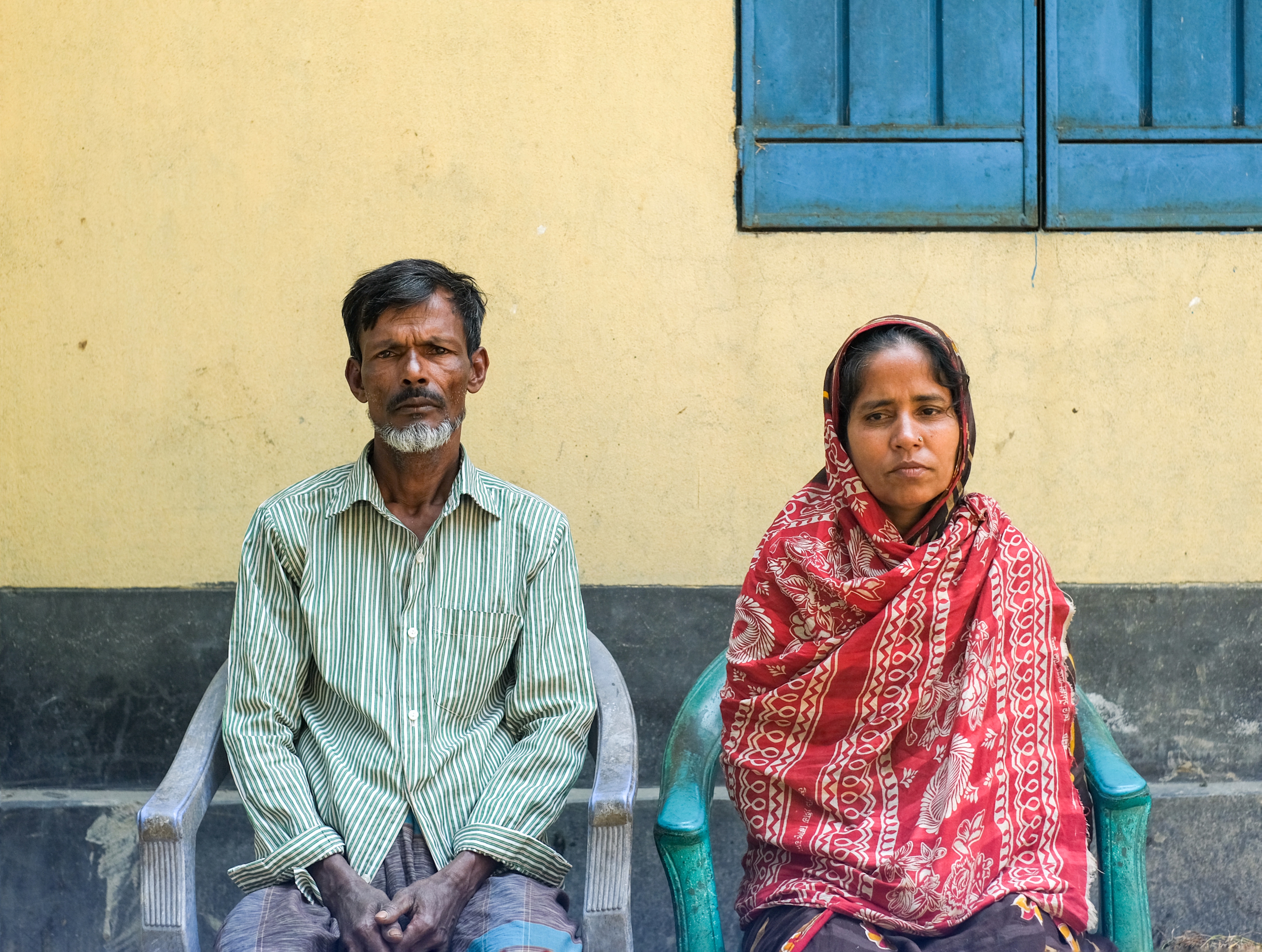
Felani Khatun’s parents, Md. Nurul Islam Nuru and Jahanara Begum. Photo by Saqlain Rizve
Failed Promises
Shortly after Felani’s death, India’s then-home minister, P. Chidambaram, expressed regret during a visit to Dhaka. He announced a policy shift, pledging that the BSF would no longer shoot civilians and would adopt non-lethal weapons. Bangladesh’s home minister echoed this, specifying the use of rubber bullets and sound grenades instead of live ammunition. Both nations agreed at a high-level meeting to aim for zero border killings.
However, the BSF has failed to keep this promise.
On January 22 of this year, a Border Guard Bangladesh (BGB) soldier, Mohammad Raisuddin, was killed by the BSF in Jalapara, Jessore, a southern district bordering West Bengal of India.
Just six days later, on January 28, 34-year-old Rafiul Islam Tiklu met a tragic end, being fatally shot by BSF members in Patgram of Lalmonirhat. Tiklu, who lived close to the border, might have been involved in smuggling, as suggested by a local representative to the media.
Not only does the BSF kill Bangladeshi civilians, but there are also reports of civilians being abducted and tortured by the Indian border force every year. From 2013 to 2023 nearly 500 civilians were abducted. In 2013 alone, 175 were abducted; among them only 49 were brought back by the BGB. The other 126 are still missing.
According to a research paper “Bangladesh-India Border Crisis: Nature and Remedy” by Dr. Saleh Shahriar, an assistant professor of history at North South University, in addition to instances of fatal shootings, Bangladeshi citizens have reported enduring various forms of torture inflicted by the BSF. These include gunshot wounds, hacking wounds, restraining individuals by tying their hands and feet before submerging them in water, using pliers to pull out nails, bayonet stabbings, ear mutilation, physical beatings, burning the entire body or specific body parts with cigarettes. Even more severe actions include burning, maiming, genital mutilation, eye gouging, hanging bodies on barbed wire, and instances of rape.
In March 2013, the BSF took six Bangladeshi children from the Parsuram-Belonia border in Feni. Locals and guardians reported that the BSF took the children while they were playing in a garden near the Indian border. Subsequently, the children were sent to jail and, after four days, handed over to the BGB. Unfortunately, such incidents are not isolated, as minors have also been reported killed by open fire at the border.
A report called released by Human Rights Watch in 2010 mentioned a tragic incident that occurred on March 13, 2009. A BSF trooper engaged in an argument with a boy fishing near the border. Eyewitnesses stated that, as the altercation escalated, “the soldier opened fire, hitting two boys who were grazing their buffaloes nearby.” Abdur Rakib, 13, was killed instantly, while Mohammad Omar Faruq, 15, sustained injuries.
A flag meeting between the BGB and the BSF was held the next day to address the incident. After initially claiming the victims were illegal cattle traders, the BSF later apologized during the meeting, promising that the responsible soldier would be punished. However, it remains unclear whether any disciplinary action was taken.
“Members of the BSF are described by local residents as unsympathetic, aggressive, and violent. This may be explained by the fact that many are deployed to the region after difficult and tense tours of duty on the India-Pakistan border in Kashmir,” the HRW report stated.
It added, “Human Rights Watch researchers witnessed BSF troopers shouting at villagers, calling them names, and often making them wait for hours as each person was searched and signed as they crossed BSF outposts, to reach their fields or homes which adjoin the border.”
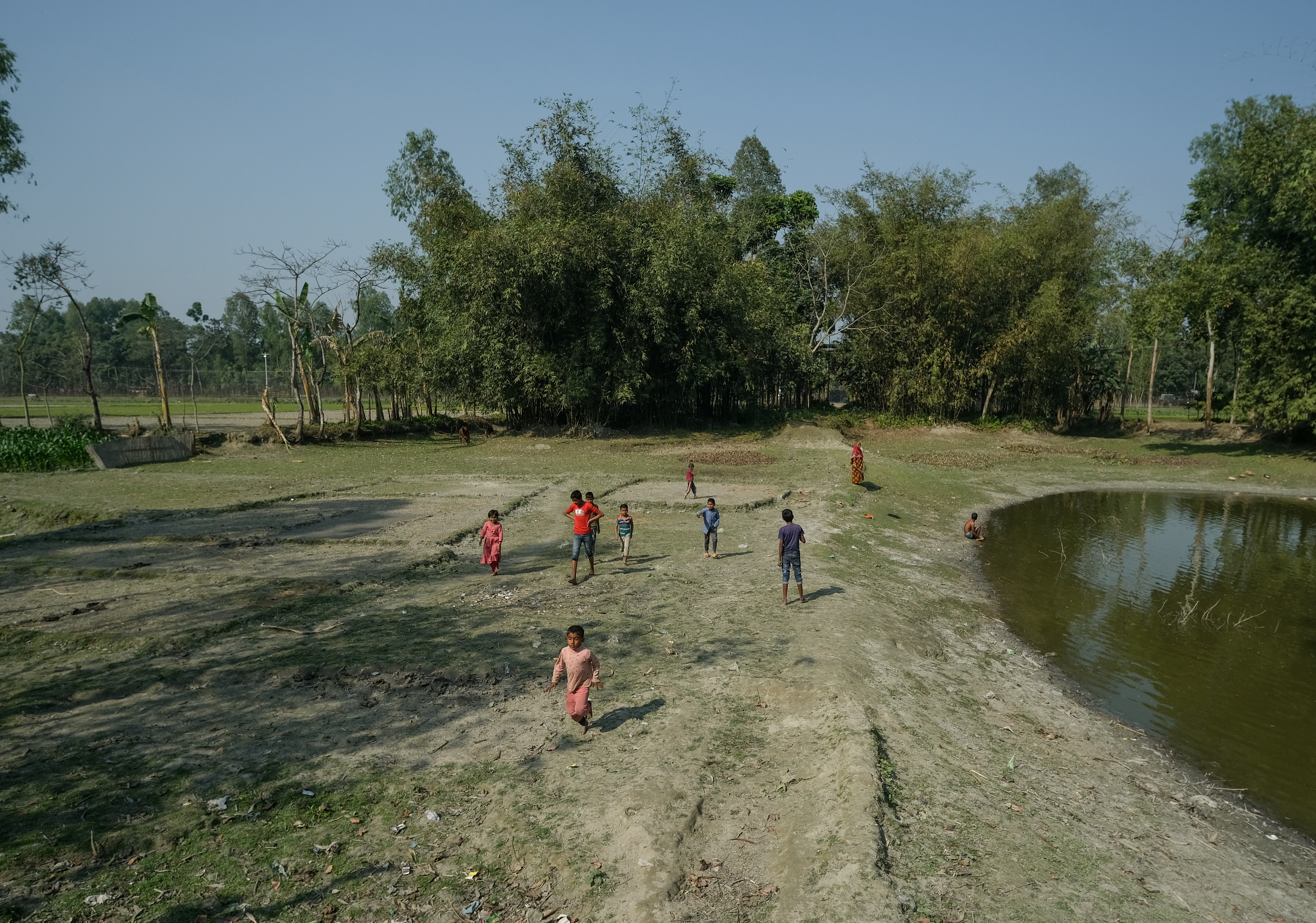
Bangladeshi children playing in the 150-yard No Man’s Land along the Bangladesh-India border. Photo by Saqlain Rizve.
No End in Sight
Many of the world’s borders pose dangers and potential conflicts. In South Asia, there are examples of intense and violent frontiers between countries like Pakistan and Afghanistan, Pakistan and Iran, India and Pakistan, India and China, and Bangladesh and Myanmar.
What sets the Bangladesh-India border apart is its lengthy history of violence, despite the friendly relations between the two governments. From 1990 to 2023, approximately 1,514 Bangladeshi civilians were killed, and numerous abduction cases occurred. While the number of incidents can fluctuate year by year, it never goes away entirely. This prolonged violence has eroded trust within border communities, even when the broader bilateral relationship appears positive.
It’s true that smuggling occurs at the border between the two countries, involving people from both sides. However, only Bangladeshis are being killed by the BSF. It’s noteworthy that Indians are not dying at the hands of BGB members.
“The BSF just hates us, I mean Bangladeshis,” Felani’s father told The Diplomat. “When we were crossing the border, there were four brokers with homes we contacted. And when the BSF members came and shot my daughter the brokers were there; however, the BSF didn’t say anything to them.”
Beyond smugglers, many Bangladeshi farmers and ordinary people and even minors have also been killed or injured by the BSF firing while going about their daily work along the border.
“There is clearly a problem here with terms of engagement and a broader sense of impunity, which gives BSFs little incentive to rein in the types of activities that kill and maim innocents,” said Michael Kugelman, director of the Wilson Center’s South Asia Institute. “Blame can be laid on the feet of senior commanders, but also on the government, for not doing more to address a long-festering problem.”
“It’s disheartening to witness killings between two friendly nations despite frequent meetings between officials,” added Sreedha Datta, dean at the Jindal School of International Affairs in India. To help find a solution, “We once suggested to Bangladesh the idea of halting movement in the border area after sunset; however, it faced criticism from many Bangladeshi media outlets.”
She explained the rationale: “During the evening, when smuggling or immigration activities take place, it becomes challenging to distinguish between a smuggler and innocent individuals. I have confidence in the competence and kindness of our security forces, but the on-ground situation sometimes forces them to resort to shooting, which is truly regrettable. Therefore, I still believe implementing restrictions on movement after sunset would be highly effective, and discussions between the two countries should be pursued more effectively.”
A Lack of Political Will
“On the diplomatic front, time and again Indian leadership have expressed their intention to bring the number of border killings to zero, but the practice has continued nonetheless,” Hossain, the former foreign secretary of Bangladesh, said. “I think diplomacy can only do so much. Stopping border killing will require the goodwill and determination of Indian political leadership, which is sadly lacking.”
“There are many things the Bangladesh government cannot, or will not do,” he continued. “Border killing, it appears to me, is not high on the government’s agenda. Sadly, sometimes Bangladesh appeared to me to be indirectly endorsing the Indian narrative of crime versus killing, laying greater emphasis on controlling the so-called trans-border crimes.”
The AL is considered a pro-Indian government and has maintained a stronger diplomatic friendship with India than any other regime in Bangladesh since its independence. As a result, in every election, New Delhi has exerted significant influence on Dhaka and supported the AL.
Prime Minister Sheikh Hasina has been in power continuously since 2009, securing a new victory in January. Bangladesh is currently labeled as an autocratic country on the global stage.
Setting aside concerns related to the autocratic regime, the Bangladesh-India friendship should provide more opportunities for cooperation. At the very least, it should lead the two peoples to regard each more positively. Consequently, there should be a reduction in violence along the border.
“Surprisingly, there isn’t substantial protest from the official side in Bangladesh regarding the border killings,” an Indian journalist told The Diplomat, speaking on condition of anonymity. “Presently, Dhaka is keen to avoid any issues with New Delhi. There appears to be a lack of resolve, and it seems Dhaka isn’t overly concerned about these incidents along the border.”













